MENU
The Electronic Scholarly Publishing Project: Providing access to classic scientific papers and other scholarly materials, since 1993. More About: ESP | OUR CONTENT | THIS WEBSITE | WHAT'S NEW | WHAT'S HOT
Comparative Timelines
The ESP Timeline (one of the site's most popular features) has been completely updated to allow the user to select (using the timeline controls above each column) different topics for the left and right sides of the display.
Select:
New Left Column
New Left Column
Dates
Decade
New Right Column
New Right Column
First U.S. census is conducted, showing a population of 3,939,214.
Society of Friends petitions Congress for abolition of slavery.
The first ten amendments to the US Constitution — The Bill of Rights — are ratified.
Washington, D.C., founded as the capitol of the United States.
1790
(no entry for this year)
Vermont admitted as 14th state (first addition to the original thirteen colonies).
Charles Babbage is Born
John Stone, Concord, Massachusetts, patents a pile driver.
 New York City traffic regulation creates first one-way street.
New York City traffic regulation creates first one-way street.
1791
(no entry for this year)
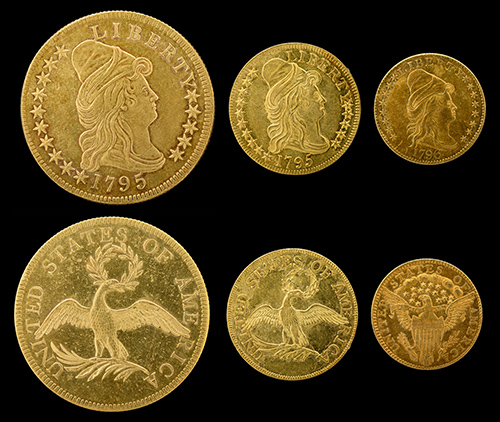 The Coinage Act of 1792 (also known as the Mint Act; officially: An act establishing a mint, and regulating the Coins of the United States), passed by the United States Congress on April 2, 1792, created the United States dollar as the country's standard unit of money, established the United States Mint, and regulated the coinage of the United States. This act established the silver dollar as the unit of money in the United States, declared it to be lawful tender, and created a decimal system for U.S. currency. The Act specified the issuing of three gold coins comprising a $10 gold coin called an "eagle", a $5 coin called a "half eagle", and a $2.5 coin called a "quarter eagle". The Act also authorized construction of a mint building in Philadelphia, the nation's capital at the time. This was the first federal building erected under the United States Constitution. Adjusted for inflation, the ten-dollar coin would be worth $231.00 in today's money. As collector's items, these gold coins have sold for more than $100,000 each.
The Coinage Act of 1792 (also known as the Mint Act; officially: An act establishing a mint, and regulating the Coins of the United States), passed by the United States Congress on April 2, 1792, created the United States dollar as the country's standard unit of money, established the United States Mint, and regulated the coinage of the United States. This act established the silver dollar as the unit of money in the United States, declared it to be lawful tender, and created a decimal system for U.S. currency. The Act specified the issuing of three gold coins comprising a $10 gold coin called an "eagle", a $5 coin called a "half eagle", and a $2.5 coin called a "quarter eagle". The Act also authorized construction of a mint building in Philadelphia, the nation's capital at the time. This was the first federal building erected under the United States Constitution. Adjusted for inflation, the ten-dollar coin would be worth $231.00 in today's money. As collector's items, these gold coins have sold for more than $100,000 each.
U.S. postal service created; postage 6–12 cents, depending on distance. (In today's dollars, that would be somewhere between $1.40 and $3.00.)
Guillotine first used (to execute highwayman Nicolas J. Pelletier).
Captain George Vancouver claims Puget Sound for Britain.
France declares war on Austria, starting French Revolutionary Wars.
The French Republic is proclaimed.
Twenty-four merchants form New York Stock Exchange at 70 Wall Street.
1792
(no entry for this year)
To enforce Article IV, Section 2, the U.S. Congress enacts the Fugitive Slave Law. It allows slaveowners to cross state lines to recapture their slaves. They must then prove ownership in a court of law. In reaction, some Northern states pass personal liberty laws, granting the alleged fugitive slaves the rights to habeas corpus, jury trials, and testimony on their own behalf. These Northern state legislatures also pass anti-kidnapping laws to punish slave-catchers who kidnap free blacks, instead of fugitive slaves.
France becomes first country to use the metric system.
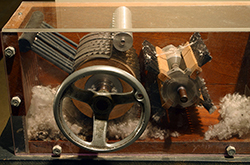 Eli Whitney invents the cotton gin (cotton enGINe), a machine that quickly and easily separates cotton fibers from their seeds, allowing for much greater productivity than manual cotton separation. By reducing the labor of removing seeds, the cotton gin made cotton growing more profitable, thereby raising demand for slave labor. The first federal census of 1790 counted 697,897 slaves; by 1810, there were 1.2 million slaves, a 70 percent increase. Slavery spread from the seaboard to some of the new western territories and states as new cotton fields were planted, and by 1830 it thrived in more than half the continent. Within 10 years after the cotton gin was put into use, the value of the total United States crop leaped from $150,000 to more than $8 million.
Eli Whitney invents the cotton gin (cotton enGINe), a machine that quickly and easily separates cotton fibers from their seeds, allowing for much greater productivity than manual cotton separation. By reducing the labor of removing seeds, the cotton gin made cotton growing more profitable, thereby raising demand for slave labor. The first federal census of 1790 counted 697,897 slaves; by 1810, there were 1.2 million slaves, a 70 percent increase. Slavery spread from the seaboard to some of the new western territories and states as new cotton fields were planted, and by 1830 it thrived in more than half the continent. Within 10 years after the cotton gin was put into use, the value of the total United States crop leaped from $150,000 to more than $8 million.
 King Louis XVI of France is executed.
King Louis XVI of France is executed.
1793
(no entry for this year)
Slavery abolished in the French colonies.
1794
 Erasmus Darwin (Charles' grandfather) publishes Zoonomia, or the Laws of Organic Life.
Erasmus Darwin (Charles' grandfather) publishes Zoonomia, or the Laws of Organic Life.
James Hutton publishes An Investigation of the Principles of Knowledge. Buried in the 2,138-page philosophical tome is a chapter about variety in nature in which Hutton anticipates Charles Darwin's theory of natural selection.
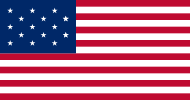 The US flag is modified to have fifteen stars and fifteen stripes, reflecting the addition of two new states: Vermont and Kentucky. This is the only US flag to have other than thirteen stripes.
The US flag is modified to have fifteen stars and fifteen stripes, reflecting the addition of two new states: Vermont and Kentucky. This is the only US flag to have other than thirteen stripes.
1795
 James Hutton's Theory of the Earth published, interpreting certain geological strata as former sea beds. Hutton proposes geological theory of gradualism.
James Hutton's Theory of the Earth published, interpreting certain geological strata as former sea beds. Hutton proposes geological theory of gradualism.
George Washington declines a third term as President, gives his Farewell Address.
1796
(no entry for this year)
Napoleon invades Egypt and defeats the Egyptians at the Battle of the Pyramids.
1798
 Publication of Thomas Malthus' Essay on the Principle of Population, a work that Darwin asserted helped him frame the principle of evolution by natural selection.
Publication of Thomas Malthus' Essay on the Principle of Population, a work that Darwin asserted helped him frame the principle of evolution by natural selection.
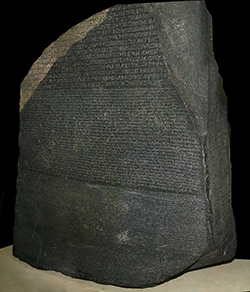 The Rosetta Stone is discovered in Egypt. The stone is a fragment of an Egyptian stele with the same inscription in three texts: ancient Egyptian hieroglyphs, Egyptian demotic script, and Greek. This side-by-side translation allows historians to translate ancient Egyptian hieroglyphs for the first time.
The Rosetta Stone is discovered in Egypt. The stone is a fragment of an Egyptian stele with the same inscription in three texts: ancient Egyptian hieroglyphs, Egyptian demotic script, and Greek. This side-by-side translation allows historians to translate ancient Egyptian hieroglyphs for the first time.
 Napoleon Bonaparte becomes First Consul and seizes power in France.
Napoleon Bonaparte becomes First Consul and seizes power in France.
1799
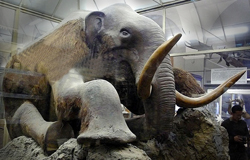 The first mammoth fossil fully documented by modern science is discovered near the delta of the Lena River in 1799 by Ossip Schumachov, a Siberian hunter. Schumachov allows it to thaw (a process taking several years) until he can retrieve the tusks for sale to the ivory trade in Yakutsk. He then abandons the specimen, allowing it to decay before its recovery. In 1806, Russian botanist Mikhail Adams rescues what remained of the specimen and brought it to the Zoological Museum of the Zoological Institute of the Russian Academy of Sciences in St. Petersburg. The specimen, which became known as the Adams Mammoth, is stuffed and mounted, and continues to be on display at the Zoological Institute.
The first mammoth fossil fully documented by modern science is discovered near the delta of the Lena River in 1799 by Ossip Schumachov, a Siberian hunter. Schumachov allows it to thaw (a process taking several years) until he can retrieve the tusks for sale to the ivory trade in Yakutsk. He then abandons the specimen, allowing it to decay before its recovery. In 1806, Russian botanist Mikhail Adams rescues what remained of the specimen and brought it to the Zoological Museum of the Zoological Institute of the Russian Academy of Sciences in St. Petersburg. The specimen, which became known as the Adams Mammoth, is stuffed and mounted, and continues to be on display at the Zoological Institute.
Charles White publishes An Account of the Regular Gradation in Man, and in Different Animals and Vegetables, a treatise on the great chain of being, showing people of color at the bottom of the human chain.
ESP Quick Facts
ESP Origins
In the early 1990's, Robert Robbins was a faculty member at Johns Hopkins, where he directed the informatics core of GDB — the human gene-mapping database of the international human genome project. To share papers with colleagues around the world, he set up a small paper-sharing section on his personal web page. This small project evolved into The Electronic Scholarly Publishing Project.
ESP Support
In 1995, Robbins became the VP/IT of the Fred Hutchinson Cancer Research Center in Seattle, WA. Soon after arriving in Seattle, Robbins secured funding, through the ELSI component of the US Human Genome Project, to create the original ESP.ORG web site, with the formal goal of providing free, world-wide access to the literature of classical genetics.
ESP Rationale
Although the methods of molecular biology can seem almost magical to the uninitiated, the original techniques of classical genetics are readily appreciated by one and all: cross individuals that differ in some inherited trait, collect all of the progeny, score their attributes, and propose mechanisms to explain the patterns of inheritance observed.
ESP Goal
In reading the early works of classical genetics, one is drawn, almost inexorably, into ever more complex models, until molecular explanations begin to seem both necessary and natural. At that point, the tools for understanding genome research are at hand. Assisting readers reach this point was the original goal of The Electronic Scholarly Publishing Project.
ESP Usage
Usage of the site grew rapidly and has remained high. Faculty began to use the site for their assigned readings. Other on-line publishers, ranging from The New York Times to Nature referenced ESP materials in their own publications. Nobel laureates (e.g., Joshua Lederberg) regularly used the site and even wrote to suggest changes and improvements.
ESP Content
When the site began, no journals were making their early content available in digital format. As a result, ESP was obliged to digitize classic literature before it could be made available. For many important papers — such as Mendel's original paper or the first genetic map — ESP had to produce entirely new typeset versions of the works, if they were to be available in a high-quality format.
ESP Help
Early support from the DOE component of the Human Genome Project was critically important for getting the ESP project on a firm foundation. Since that funding ended (nearly 20 years ago), the project has been operated as a purely volunteer effort. Anyone wishing to assist in these efforts should send an email to Robbins.
ESP Plans
With the development of methods for adding typeset side notes to PDF files, the ESP project now plans to add annotated versions of some classical papers to its holdings. We also plan to add new reference and pedagogical material. We have already started providing regularly updated, comprehensive bibliographies to the ESP.ORG site.
ESP Picks from Around the Web (updated 06 MAR 2017 )
Old Science

Weird Science

Treating Disease with Fecal Transplantation
Fossils of miniature humans (hobbits) discovered in Indonesia

Dinosaur tail, complete with feathers, found preserved in amber.
Astronomy

Mysterious fast radio burst (FRB) detected in the distant universe.